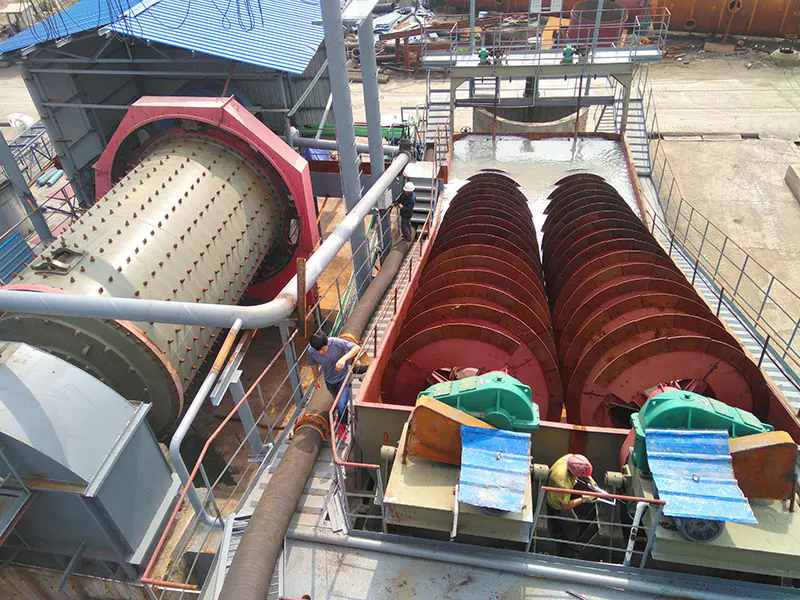 English
English Español
Español  Português
Português  русский
русский  Français
Français  日本語
日本語  Deutsch
Deutsch  tiếng Việt
tiếng Việt  Italiano
Italiano  Nederlands
Nederlands  ภาษาไทย
ภาษาไทย  Polski
Polski  한국어
한국어  Svenska
Svenska  magyar
magyar  Malay
Malay  বাংলা ভাষার
বাংলা ভাষার  Dansk
Dansk  Suomi
Suomi  हिन्दी
हिन्दी  Pilipino
Pilipino  Türkçe
Türkçe  Gaeilge
Gaeilge  العربية
العربية  Indonesia
Indonesia  Norsk
Norsk  تمل
تمل  český
český  ελληνικά
ελληνικά  український
український  Javanese
Javanese  فارسی
فارسی  தமிழ்
தமிழ்  తెలుగు
తెలుగు  नेपाली
नेपाली  Burmese
Burmese  български
български  ລາວ
ລາວ  Latine
Latine  Қазақша
Қазақша  Euskal
Euskal  Azərbaycan
Azərbaycan  Slovenský jazyk
Slovenský jazyk  Македонски
Македонски  Lietuvos
Lietuvos  Eesti Keel
Eesti Keel  Română
Română  Slovenski
Slovenski  मराठी
मराठी  Srpski језик
Srpski језик
What Makes Spiral Classifiers the Key to Efficient Mineral Processing ?
2025-11-03
A Spiral Classifier is an indispensable piece of equipment widely used in the mining, metallurgy, chemical, and mineral processing industries. It plays a crucial role in the classification, separation, and dewatering of fine materials based on particle size and specific gravity. Its spiral design and mechanical structure make it capable of separating light and heavy mineral particles in a liquid slurry, creating a precise and efficient classification process essential to downstream grinding and beneficiation operations.
The core working principle of a spiral classifier lies in its ability to utilize the difference in sedimentation speed of solid particles in a liquid. Heavier particles settle at the bottom and are pushed upward by the rotating spiral blades toward the discharge point, while finer particles remain suspended in the liquid and overflow through the weir for further processing. This continuous motion ensures consistent classification results, making spiral classifiers a cornerstone of modern mineral separation systems.
The key benefits of spiral classifiers include high reliability, low operating cost, simple structure, and precise particle size control. They are often paired with ball mills or hydrocyclones in grinding circuits, ensuring closed-loop control over particle size distribution and improving the overall recovery rate of valuable minerals.
Below is a detailed technical specification overview illustrating the performance and construction of a standard spiral classifier:
| Parameter | Specification Range | Description |
|---|---|---|
| Spiral Diameter | 300 mm – 3000 mm | Determines capacity and classification accuracy |
| Spiral Speed | 2 – 15 rpm | Adjustable based on slurry density and feed size |
| Processing Capacity | 50 – 10,000 t/day | Depends on model size and mineral characteristics |
| Overflow Particle Size | 0.074 – 0.3 mm | Ideal range for fine material classification |
| Tank Length | 3 – 12 meters | Longer tanks improve separation efficiency |
| Power Requirement | 2.2 – 18.5 kW | Varies with classifier size and load |
| Water Consumption | 0.3 – 1.5 m³/ton of material | Dependent on slurry density and feed rate |
| Material of Construction | High Manganese Steel / Rubber Lined | Provides wear resistance and corrosion protection |
| Control Mode | Manual / PLC Automated System | Optional configurations for operational convenience |
Why Spiral Classifiers Are Essential for Modern Mineral Processing
The demand for spiral classifiers has risen significantly due to the global emphasis on energy efficiency, sustainability, and resource recovery in the mineral industry. Their robust construction, mechanical simplicity, and ability to deliver consistent separation performance make them an essential part of modern beneficiation circuits. But what exactly makes them indispensable?
Precise Classification
Spiral classifiers ensure accurate separation of fine particles from coarse material, which is critical in achieving optimal grinding efficiency. Proper classification enhances the quality of downstream processes such as flotation or magnetic separation.
Cost-Efficiency and Low Maintenance
The machine’s design minimizes wear and tear while maintaining consistent operation. Compared with hydrocyclones, spiral classifiers consume less power and can handle larger volumes of slurry with reduced maintenance downtime.
Environmental Sustainability
Modern spiral classifiers are engineered with water-saving mechanisms and recyclable materials, supporting green mining initiatives. The integration of advanced automation allows real-time monitoring, ensuring precise water and energy usage.
Adaptability to Various Applications
Spiral classifiers can handle a wide range of materials, including iron ore, gold, coal, sand, and non-metallic minerals. Their flexibility makes them suitable for both open-circuit and closed-circuit systems.
Integration with Smart Control Systems
With advancements in industrial automation and digital monitoring, spiral classifiers now integrate seamlessly with PLC control systems and IoT platforms. This integration enables continuous optimization, predictive maintenance, and enhanced productivity.
The growing focus on process automation and digital transformation in the mining industry indicates that spiral classifiers will continue to evolve into more intelligent and efficient systems, supporting both sustainability and profitability in the years ahead.
How Spiral Classifiers Are Shaping the Future of Separation Technology
The future of spiral classifier design and operation lies in innovation, efficiency, and automation. Emerging trends are transforming this traditional equipment into a data-driven and environmentally friendly solution.
Smart Automation and AI Integration
The next generation of spiral classifiers is being developed with automated sensors, variable speed drives, and real-time monitoring systems. These upgrades allow precise control over slurry flow rate, spiral rotation speed, and overflow density, resulting in higher accuracy and reduced human error.
Sustainable Design and Material Optimization
Manufacturers are moving toward the use of corrosion-resistant alloys and polymer composites for longer equipment lifespan. Enhanced wear-resistant coatings reduce maintenance intervals, lowering total cost of ownership and environmental impact.
Modular and Scalable Systems
Future designs focus on modular construction, allowing rapid installation, easier transportation, and flexible capacity upgrades. This adaptability supports the mining industry’s shift toward smaller, decentralized processing facilities.
Enhanced Energy Efficiency
The combination of optimized hydraulic flow channels and energy-saving drive systems is reducing energy consumption without compromising performance. These advancements make spiral classifiers more competitive compared with hydrocyclones and mechanical separators.
Integration into Circular Economy Frameworks
Spiral classifiers are increasingly being used to recover valuable by-products from tailings, contributing to resource recycling and sustainable waste management. This approach aligns with the global transition toward circular economy models in mining and mineral processing.
Common Questions About Spiral Classifiers
Q1: What factors should be considered when selecting the right spiral classifier for a processing plant?
A1: The selection depends on several parameters including feed particle size, material density, slurry concentration, and desired separation precision. Other factors such as processing capacity, installation space, and maintenance requirements also influence the choice. For large-scale operations, high-capacity spiral classifiers with variable speed control and automatic discharge systems are preferred for maximum efficiency and minimal downtime.
Q2: How can a spiral classifier improve mineral recovery rates?
A2: A spiral classifier enhances mineral recovery by ensuring that finely ground valuable particles are efficiently separated from coarse waste. This allows more precise feed control to downstream flotation or leaching units, reducing material losses and improving the overall yield of valuable minerals. By maintaining consistent classification quality, spiral classifiers directly contribute to higher plant recovery rates and improved profitability.
Conclusion: The Future of Spiral Classifiers with EPIC
The Spiral Classifier has evolved from a simple mechanical separator into a highly efficient, data-driven, and sustainable processing solution. As global industries move toward smarter and greener operations, the role of spiral classifiers in improving classification accuracy, reducing operational costs, and supporting resource recovery continues to expand.
EPIC, as a trusted name in mineral processing equipment, is at the forefront of these innovations. Its spiral classifiers are engineered with precision, durability, and technological sophistication, ensuring optimal performance across various applications — from fine sand classification to ore beneficiation.
For businesses seeking to enhance their mineral processing efficiency and adopt sustainable technologies, investing in advanced spiral classifiers from EPIC is a strategic move toward operational excellence.
Contact us today to learn more about how EPIC Spiral Classifiers can transform your separation and classification process with cutting-edge performance and long-term reliability.





